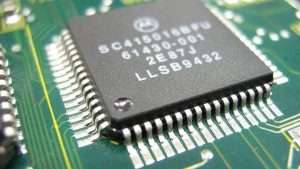Let’s start the complete discussion about the important topic ” what is a semiconductor”. If you read the complete article then you solve the all-important question of the semiconductor topic.
What is a Semiconductor?
Semiconductors are those materials that have a conductivity between conductors (silver, copper, etc) and insulators (glass, diamond, etc). Classification of semiconductors:

Intrinsic Material
An intrinsic type of semiconductor material is made to be very pure chemically. As a result, intrinsic material possesses a very low conductivity level having a very few number of charge carriers, namely holes, and electrons, which it possesses in equal amounts.
Extrinsic Material
Extrinsic types of semiconductor materials are those where a small amount of impurity is added to the basic intrinsic materials. This doping uses an element from different periodic table groups. Hence, it will either have more or fewer electrons in the valence band than the semiconductors themselves. This creates either a spare or a shortage of electrons. In this way, two types of semiconductors are produced.
N-type Semiconductor
The N-type semiconductor material has an excess of electrons. In this way, free electrons are available within the lattices, and their overall movement in one direction under the influence of a potential difference results in an electric current flow. Therefore, In N-type semiconductors the charge carriers are electrons.

P-type Semiconductor
In a P-type semiconductor material, there is a shortage of electrons that is there are holes in the crystal lattice. Electrons may move from one empty position to another and in this case, it can be considered that the holes are moving. This can happen under the influence of a potential difference and the holes can be seen to flow in one direction resulting in an electric current flow. A P-type semiconductor is actually harder for holes to move than for free electrons to move and, therefore, the mobility of holes is less than that of free electrons. Holes are positively charged carriers.

Semiconductor Materials
Many different types of semiconductor materials can be used in electronic gadgets. Each has its advantages, disadvantages, and areas where it can be used to offer the optimum performance.
Germanium
Germanium was used in many early devices from radar detection diodes to the first transistors.
Silicon
Silicon is the most widely used type of semiconductor material. Its major advantage is that silicon is easy to fabricate and provides good general electrical and mechanical properties. Another advantage is that when it is used for IC (integrated circuits), it forms high-quality silicon oxide that is used for insulation layers between active elements of the IC.
Gallium arsenide
Gallium arsenide is the second most widely used type of semiconductor. It is widely used in high-performance RF devices where its high electron mobility is utilized. It is used as a substrate for other III-V semiconductors, e.g. In Galn and GaAs. Nevertheless, it is a brittle material and has lower hole mobility than silicon.
Silicon carbide
Silicon carbide is used in power devices where its losses are quite low and operating temperatures are higher than those of silicon-based devices. It has a breakdown capability that is about ten times that of silicon itself.
Gallium nitride
Gallium nitride is starting to be more widely used in microwave transistors where high temperatures and power are needed. It is also used in some microwave ICs. It has been also used in some blue LEDs.
Gallium phosphide
Gallium phosphide found many uses within LED technology from low to medium brightness LEDs producing a variety of colors depending on the addition of other dopants. Pure Gallium phosphide produces a green color light, when nitrogen-doped, it emits yellow-green and when ZnO-doped, it emits red.
Cadmium sulfide: Cadmium sulfide is used in photo-resistors and solar cells.
Lead sulfide: Lead sulphide as the minerals galena in the very early radio detectors known as Cat’s Whiskers’ where a point contact was made with the tin wire onto the galena to provide the rectification of the signals.
Types of Semiconductors
A semiconductor is used in several applications but can be divided into four categories based on the number of terminals the semiconductor has:
- Two-terminal
- Three-terminal
- Four-terminal
- Multi-terminal
What is the Diode?
It is a two-terminal device whose state is dependent on the external power current to which it is connected. A diode has active electrodes between which a signal flows, following the direction of the current flow.
The function of a diode, on a basic level, is to direct the flow of electrical current, allowing it to flow in one direction but not the other. LEDs are a famous example of two-terminal devices and are used in several industries.
An ideal diode when forward biased offers zero resistance and acts as a short circuit. When reverse bias offers infinite resistance and acts as an open circuit.
Knee voltage: Knee voltage is defined as the forward voltage at which the current through the junction starts increasing rapidly.
Diode, forward or reverse biased: In a p-n junction diode when the p-side is connected to the positive terminal and the n-side to the negative terminal of the battery. The diode is called biased. When the p-side is connected to the negative terminal and the n-side to the positive terminal of the battery, the diode is said to be reverse-biased. A battery acts as a reverse bias to majority charge carriers but a forward bias for minority carriers.
What is Triode?
A triode is a three-terminal device whose state is dependent not only on its external power circuit but also on the signal on its driving terminal or gate. Triodes transfer the electrical resistance. These can be used as amplifiers, switches, or oscillators. They can be used individually in discrete components, or large numbers as part of an integrated circuit (IC).
Four-terminal Device
It converts a signal from one form of energy to another form of energy. These devices have a source, drain, gate, and body terminal, and are used for amplifying and switching electronic signals and power, much like three-terminal devices. For example, these four-terminal devices can be used in a light switch circuit, converting high power to low power for use in domestic lighting.
Multi-terminal Devices
These devices have several terminals that can perform a number are integrated circuits, which are used in virtually all electronic equipment today. Because the material, usually silicon, is all at the same time, rather than connected one by one, these devices are affordable and relatively quick to produce. The construction of these devices also allows for quicker functions.
Also Read: Current Electricity Notes
- Why semiconductors are important?
Answer: Semiconductors have two important properties:
- Can control the number of charge carriers which means, conductivity can be controlled.
- Can give Unidirectional current.
We hope you like this post ” What is a Semiconductor?”. Comment below for other topics.
Like This article is very helpful for me
Thanku for sharing this article
thanks and read regular post